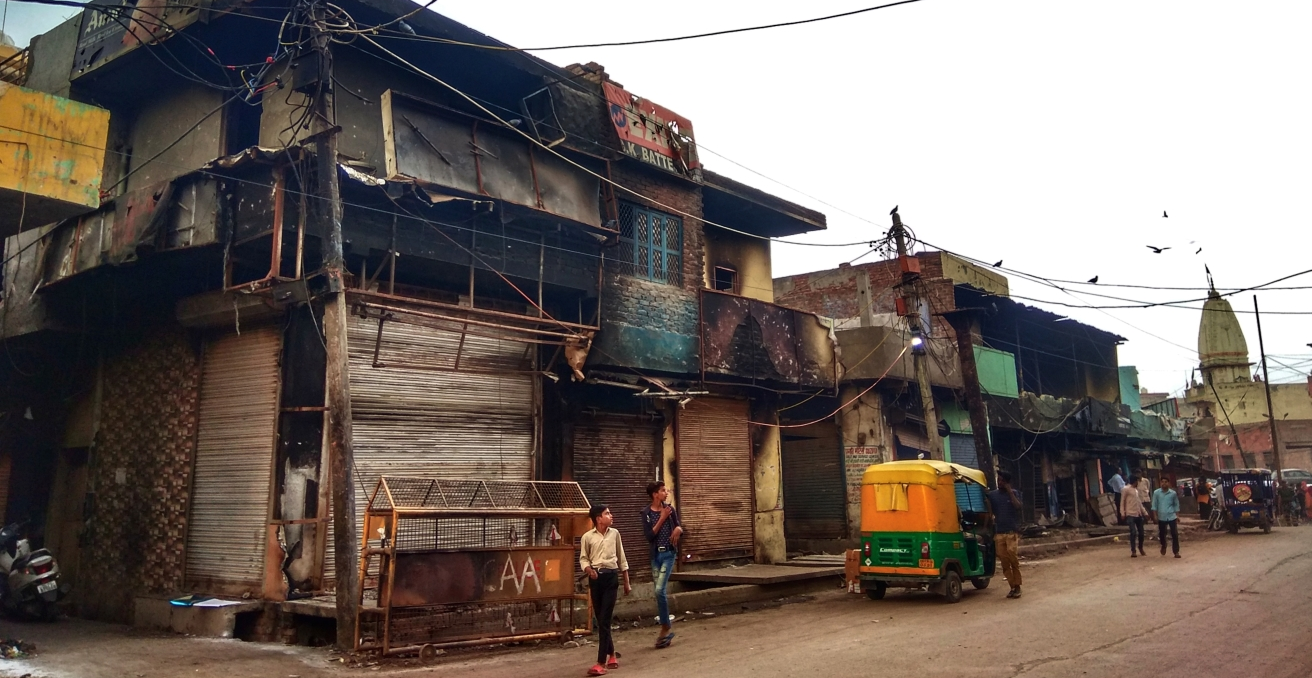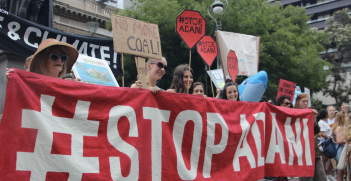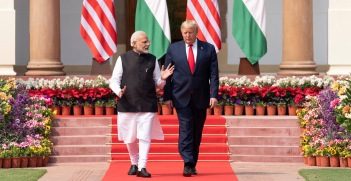Delhi in Flames

Last month’s deadly riots in Delhi were a state-sponsored pogrom. To prevent an uncontrollable mass tragedy that could destabilise the Asia–Pacific region, friendly governments must speak out now.
Mohammad Anees is a 29-year Muslim constable with the paramilitary Border Security Force (BSF). He is currently posted in Radhabari (near Siliguri) along India’s northeastern border. In the four days of madness from 23–26 February during which rioters ran unchecked and destroyed entire neighbourhoods of northeast Delhi, his home was attacked and torched to smouldering ruins. Fortunately his family managed to escape before the mob arrived. The BSF has decided to contribute one million rupees towards the cost of rebuilding his house and will task its engineering units to assist, so he can proceed with his wedding plans.
Meanwhile the city and nation remain on edge. The riots, with a toll of 53 dead and over 200 injured by 6 March, were the deadliest outbreak of violence in Delhi since the anti-Sikh pogrom of 1984 after PM Indira Gandhi was assassinated by two Sikh bodyguards. It’s fairly safe to assume that both Hindus and Muslims perpetrated acts of violence but it’s also equally clear that the primary perpetrators were Hindus and over 70% of victims (35 of 49 until the count increased) were Muslims. Having left India in 1971, I read about and watched TV coverage from abroad of the 1984 riots in which 2,000-3,000 Sikhs were butchered, the demolition of the Ayodhya mosque in 1992, and the anti-Muslim riots in Gujarat in 2002 in which up to 2,000 Muslims were killed. On this occasion I was in India and watched Delhi go up in flames with mounting disbelief, horror, and anger.
Commentators have likened the riots variously to Kristallnacht (Crystal Night or Night of Broken Glass, symbolising the shattering of Jewish existence in the Nazi regime) in Germany on 9/10 November 1938; Delhi in 1984; and Gujarat in 2002. The riots did indeed have elements that recalled all these previous incidents. In the increasingly toxic political atmosphere under the Modi government, dissent is sedition and a dissenting Muslim is a traitor. Policemen studiously averted their gaze from the criminal acts before their eyes; some abetted the violence. BJP leaders who openly incited mobs to shoot the traitors are yet to be arrested and charged. While Delhi burnt, not one minister visited the riot-hit areas, not even PM Narendra Modi. Home Minister Amit Shah was at best guilty of a grave dereliction of duty, and at worst he was the political mastermind behind the pogrom. On the fourth day, National Security Adviser Ajit Doval, himself a former top cop, finally went on a well-publicised tour of the smouldering neighbourhoods, but it was too little and too late to reassure the terrified residents.
The poisonous Hindutva project
Looking back at Modi’s first term (2014–19), hate speech and acts targeted Muslims through cow vigilantism, reconversion to Hinduism, and vitriol and violence at inter-faith couples. Looking forward, the anti-Muslim agenda has been operationalised in the Citizenship (Amendment) Act (CAA) passed by Parliament in December 2019 and the proposed National Register of Citizens (NRC) and National Population Register (NPR). The three together will enable authorities to declare that millions of Muslims cannot claim nor prove Indian citizenship in a document-poor country. They will then either be deported or held in detention camps akin to concentration camps. The end goal is to marginalise them, denude India of Muslims, and transform it into a Hindu Rashtra (nation).
I have argued elsewhere that the CAA-NRC-NPR unholy trinity is wrong in principle, not feasible in practice and will produce profoundly anti-national consequences. The Delhi riots are powerful proof of all three pathologies. They were manifestly state-sponsored. Was Shah punishing the citizens of Delhi for the BJP’s humiliating defeat in local elections fought by the party on its Hindutva agenda of aggressive majoritarian nationalism? Or perhaps punishing those who have protested for months against the CAA-NRC-NPR agenda? Former Home Minister P. Chidambaram suspects that polarisation along religious lines is a deliberate strategy by the Modi government to consolidate the Hindu vote.
Ironically, as Jairaj Devadiga notes, Modi has embraced many of Jawaharlal Nehru’s statist nostrums while rejecting the admirable parts of his legacy with respect to good governance in a vast multi-religious country. Modi’s Hindutva agenda supporters, known popularly as “bhakts” (worshippers), are the Indian analogue of Trump’s unshakeable MAGA (Make America Great Again) base. It was shocking to hear many assert openly that having partitioned the country on religious lines, all Muslims should have left for Pakistan. They argue that Muslims have several countries and, like Jews in Israel, Hindus too deserve a national homeland they can call their own.
The core elements of the Hindu Rashtra project include not just an end to the pandering of minority fundamentalism of which Congress Party governments were guilty for many decades. They go further in insisting on Hindu primacy where Hindus are more equal than others, laws and rules align with Hindu sentiments and practices, religious diktat regulates people’s lives in a Talibanisation of Indian society with respect to diet, dress, and decorum, and minorities know their place and stay there.
In the prioritised pursuit of this agenda, Modi and his army of bhakts have fallen into a fatal trap. Development, growth and the emergence of a large and prosperous middle class will provide the essential underpinnings to promote Indian culture and Hindu philosophy globally, much as China has bankrolled the network of Confucius institutes. Conversely, pushing the cultural agenda at the cost of rapid and sustained economic growth will undercut India’s material capacity for cultural diplomacy while also inflicting substantial reputational harm. A return to persistent mass poverty under protectionist barriers and statist economic regulations will regenerate contempt for the “Hindu rate of growth.” Hindu–Muslim riots in the nation’s capital are a business risk and a disincentive to foreign investors.
Diplomatic costs
Scarce diplomatic capital is also being frittered away in defensive responses to mounting international criticism. The riots were at their worst during President Donald Trump’s high-profile first visit to India. Trump’s speech in the capacious Motera Stadium in Ahmedabad on 24 February was Obama-like in praising India’s history of democracy, tolerance, diversity, and pluralism. Yet subsequently he merely said it was for India to handle the anti-CAA agitation. But his potential (but after the primaries this week, highly unlikely) Democratic opponent Bernie Sanders has been sharply critical of India’s growing intolerance and illiberalism, as have some Representatives like Pramila Jayapal, the first Indo-American woman elected to the House. So has the US Commission on International Religious Freedom.
Modi has been schizoid in his Hindutva domestic and secular foreign policies. Even while maintaining a studied silence on the assault against Muslims at home, he has consciously cultivated ties with Islamic countries like Indonesia, Iran, and the Gulf states. Unsurprisingly, many Muslim countries have been highly critical of the CAA etc. agenda, from Bangladesh, Malaysia, and Indonesia to Iran, Turkey, and the 57-member Organisation of Islamic Cooperation. India’s new laws have also attracted criticism from MPs of all parties in the UK Parliament and some European countries. Most tellingly, the UN High Commissioner for Human Rights has formally requested the status of a friend of the court when the legal challenge to the CAA comes up for hearing in the Supreme Court of India.
In all cases, like a broken record, India’s official response is that this is an internal matter and foreigners should refrain from making any comments. This is rubbish. With the steady universalisation of the human rights norm and international humanitarian law over the past 100 years and the growth of UN-centred human rights monitoring machinery, the use of state violence – either internally against citizens or internationally against other countries – is subject to international normative benchmarks and scrutiny. The tiresome mantra of “internal matter” is a self-indicting refrain deployed by unsavoury regimes but eschewed by enlightened ones.
Restoring Modi’s damaged reputation
In 1938 other countries ignored the tell-tale warnings that presaged the full horror of the Holocaust that unfolded in initially slow and then rapidly accelerating motion. It would be a mistake, for reasons of values and also prudential politics, to stay silent on the abhorrent trajectory that the Modi government has set for India. Much of the political justification for Australia, Canada, Europe, Japan and the US consolidating ties with India as a geopolitical counterweight to China has emphasised shared political values of democracy, freedoms, civil liberties, and the rule of law. Every element of that is under threat from the Modi regime. In addition, a stalled economy means India ceases being an attractive market and trade partner and mass poverty will significantly degrade its military potential.
Conversely, the irreversible alienation of disaffected Muslim citizens will destroy India as the firebreak for Islamist extremism that has infected North Africa, the Middle East, Afghanistan, and Pakistan. With another 180 million Muslims radicalised, India itself would become the epicentre of Islamist extremists that produces more terrorism than can safely be consumed at home and will be exported to Asia, the Pacific, and Australasia. Thus friendly democracies have little to lose in the medium term by criticising growing Hindu intolerance and much to lose in the long term by maintaining diplomatic reticence.
There will also be fresh waves of mass refugees if the implementation of the CAA-NRC-NPR trifecta creates the largest pool of stateless people in the world, as the world’s foremost authority on the history of Hindu–Muslim riots, Ashutosh Varshney, warns. Friendly countries must make representations at the highest level to Modi for urgent course correction. They should do so privately in the first instance but, if he refuses to heed their counsel, they must make their displeasure known publicly and increase concerted international pressure.
To begin with, the CAA should be amended to remove the mention of any religion and the specification of three countries, such that it applies to all persecuted minorities in all neighbouring countries, for example Myanmar’s Rohingyas. The broader reform agenda must include the depoliticisation, independence, impartiality, and professionalism of police forces with respect to recruitment, training, promotion, deployment, intelligence gathering, and modern equipment. There is an equally urgent need to restore the institutional integrity of the judiciary. On 26 February, Justice S. Muralidhar of the Delhi High Court was harshly critical of the Modi government and Delhi Police tardiness in acting against purveyors of hate speech, saying the court would not let “another 1984” happen on its watch. He demanded that charges be filed within 24 hours against the hate-mongers whose incendiary speeches, widely available on video, were played in the courtroom.
In December 2018, more than three decades after “1984,” Muralidhar was one of two judges who convicted the last of the instigators of the murderous attacks on the Sikhs in 1984. The court pronounced that “The accused enjoyed political patronage and escaped trial.” This was a major embarrassment for the Congress Party, so the judge cannot credibly be accused of being a Congress stooge. Despite this, Muralidhar was transferred to the Punjab and Haryana High Court at midnight and the next day, the Delhi High Court gave the police an extra four weeks to file charges. Mercifully the Supreme Court intervened and said the adjournment of the case was unjustified.
Yet the Supreme Court itself cannot be absolved of having abdicated its share of responsibility for the slowly-developing tragedy. It has previously stepped gingerly around a string of anti-Muslim measures by the Modi government that in retrospect were staging posts for the CAA-NRC-NPR project. An editorial in The Indian Express noted the Court’s troubling record in having given the benefit of doubt to the government in several cases on sedition and habeas corpus. And on 26 February the Supreme Court Bar Association censured Justice Arun Mishra for having publicly praised PM Modi as an “internationally acclaimed visionary” and a “versatile genius who thinks globally and acts locally.” The Times of India report of the censure motion noted that Justice Mishra retires on 2 September. He will thus be in the market for a post-retirement appointment as ambassador, state governor or other posts within the purview of the PM.
Conclusion
Modi’s global brand has taken a severe battering. To recover from the ruins and restore his tattered reputation, Modi must expeditiously remove Shah from the cabinet and oust the venom-spewing Yogi Adityanath who was hand-picked by Modi as chief minister of Uttar Pradesh, the country’s politically most important state; expel hate speech MPs like Sadhvi Pragya Thakur, Kapil Mishra, and Giriraj Singh from the party; and visibly shift focus from the cultural Hindu to the development and good governance agenda that brought him to power in 2014 in the first place. Conversely, if he doubles down on this religiously bigoted, economically ruinous and diplomatically damaging cultural agenda, the reputation of every single member of his cabinet will be sullied.
Ramesh Thakur, a former United Nations Assistant Secretary-General, is emeritus professor in the Crawford School of Public Policy, Australian National University.
This is a revised version of an article originally published in Pearls and Irritations on 13 March.





